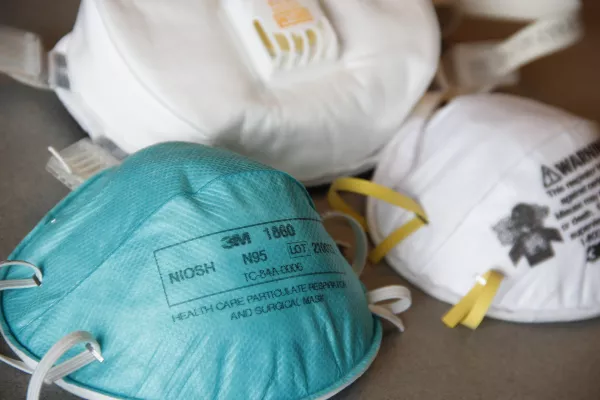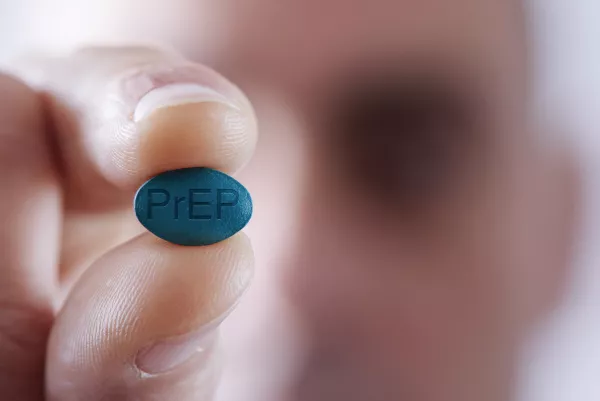Research Recap: October 11 - November 5

A biweekly overview of recent studies published by Institute investigators and their collaborators spans a wide variety of topics, including:
The expanding body of knowledge around COVID; new sepsis surveillance methods; patient-reported outcomes/measures and genetic testing; cancer drug spending; high-cost high-need Medicaid populations; academic detailing and PrEP; intergenerational medical decision making; a possible link between influenza and Parkinson’s risk; ventilator associated events and COVID-19; PrEP continuum of care among transgender individuals; protocols of genetic biobanks; and the effect of COVID-19 on basic scientific research.
For all faculty publications, see our Publications page. For up-to-date media coverage and research findings, visit In the Media, and follow us on Twitter. To search for a subject matter expert, visit our Investigator Directory.

Michael Klompas and Chanu Rhee have been at the front lines of the COVID-19 pandemic since its start. In a new CHEST editorial, they discuss two studies highlighted in the issue, which look closely at aerosol generation and mitigation. Studies like the two discussed contribute to our understanding of the difference between droplets versus aerosols: ironically, that there is little distinction between droplet- and aerosol-based transmission, as people produce respiratory particles in a range of sizes, with no clear line between droplets and aerosols. What does this mean for protecting health care workers? Drs. Klompas and Rhee say the implication is that N95s and negative-pressure rooms should be prioritized based on patients’ viral load, symptoms, and activities rather than on the basis of procedures.
Institute Investigator(s): Michael Klompas and Chanu Rhee
New methods of surveilling sepsis: benefits and drawbacks
The limits of using administrative data to track sepsis rates has led to a rising interest in using electronic health record (EHR) data. A new editorial by Michael Klompas and Chanu Rhee in Critical Care Medicine discusses potential positives and negatives to surveilling sepsis rates using Sepsis-3 criteria applied to EHR data. The authors discuss studies that show how Sepsis-3 criteria can be successfully applied to and operationalized using EHR data in both singular and multicenter settings. They also point out potential pitfalls to wide-scale automated Sepsis-3 surveillance, including lack of consensus on defining infection in EHR data, the complicated nature of implementing sequential organ failure assessment (SOFA) scores into EHR data, and the lack of baseline SOFA scores for patients presenting at the hospital with acute illness. They suggest that applying Sepsis-3 criteria to EHR data could benefit from ongoing refinement, validation, and standardization to be a successful surveillance method.
Institute Investigator(s): Michael Klompas and Chanu Rhee
The potential of using patient-reported outcomes and measures following genetic testing
A new topic synopsis in the Journal of Patient-Centered Research and Reviews by former research fellow Rachele Hendricks-Sturrup and senior author Christine Lu focuses on how patient-reported outcomes (PROs) and PRO measures (PROMs) are often used to assist both clinicians and researchers in understanding how patients feel/are reacting to an intervention. They note that PROs and PROMs have significant value in their potential to inform health systems, policy, and payers on the utility of genetic testing. In this case, they focus on the role of and implications for PROs and PROMs following genetic testing for familial hypercholesterolemia.
Institute Investigator(s): Christine Lu

A new study led by research fellow Mahnum Shahzad with senior author Anita Wagner estimates Medicare spending on 10 accelerated approval cancer drug indications reevaluated by the FDA. The team estimated Medicare spending on the 10 accelerated approval cancer indications with confirmed lack of overall survival benefit that were reevaluated by the FDA. Study results, published in JAMA Internal Medicine, show that Medicare Part B and D cumulatively spent at least $569 million between 2017-2019 on the 10 cancer indications following accelerated approval. Approximately $224 million of this spending was for indications that were later either voluntarily withdrawn by the manufacturers or recommended by the FDA’s Oncologic Drugs Advisory Committee for withdrawal.
Institute Investigator(s): Mahnum Shahzad, Anita Wagner
Cancer drugs without proven overall survival benefit account for substantial spending
Despite growing concerns about the evidence supporting new cancer drug approvals, launch prices in the U.S. have substantially increased in recent years. A new study led by former research fellow Cathy Fu with Darren Toh, Dennis Ross-Degnan, and senior author Anita Wagner focuses on the use of and spending on oral targeted cancer drugs among U.S. residents with employer-sponsored health insurance between 2011 and 2018. The team used deidentified claims data from insurers to examine the uptake and cost implications of 44 new oral targeted cancer drugs among a sample of 37,348 U.S. residents with private, employer-sponsored insurance. Results, published in JAMA Internal Medicine, showed that although most individuals received drugs for which evidence from randomized clinical trials existed, a growing share of patients received drugs without documented overall survival benefit. The proportion of patients receiving drugs without documented overall survival benefit increased from 13% in 2011 to 59% in 2018, accounting for 52% of the $3.5 billion estimated cumulative spending on 44 new oral targeted cancer drugs by the end of 2018.
Institute Investigator(s): Dennis Ross-Degnan, Darren Toh, Anita Wagner
The effects of too-broad categories on high-need high cost populations
A single ‘high-need high-cost’ designation tends to combine a group of patients with varied needs into one category. The drawback to this is that programs aimed at improving quality of care or reducing utilization of care for Medicaid patients who meet this designation have fallen short. A group including Dennis Ross-Degnan sought to disaggregate clinically diverse subgroups of a population of high-cost high-need Medicaid patients. Results, published in BMC Health Services Research, show that disaggregating subgroups of high-cost-high-need patients identified clusters of patients who may have unique needs. Segmenting these populations may be an effective strategy to improve the effectiveness of complex case management programs.
Institute Investigator(s): Dennis Ross-Degnan

What is academic detailing, and how is it used to increase prescription of pre-exposure prophylaxis (PrEP)? A new article in American Journal of Preventive Medicine led by Douglas Krakower delves into this topic. Many patients who could benefit from PrEP aren’t prescribed it, as the prescribers (primary care and generalist clinicians) see them when they’re healthy. Academic detailing, or outreach education that engages with clinicians in small group or 1-on-1 settings focused on identifying and addressing a clinician’s needs to increase their use of evidence-based practice, has been proven in many other scenarios. The authors suggest that, especially in the wake of the COVID-19 pandemic, increasing academic detailing virtually would be an important step toward ending the HIV epidemic in the United States.
Institute Investigator(s): Douglas Krakower
Does having the flu increase your long-term chances of developing Parkinson Disease?
A case-controlled study led by Noelle Cocoros, published in JAMA Neurology, takes a closer look at whether prior influenza and other infections are associated with a long-term risk of developing Parkinson disease (PD). The team looked at all Danish citizens with Parkinson disease between 2000 and 2016 and found that the odds of Parkinson disease increased by more than 70% for PD occurring more than 10 years post-influenza infection. The odds were approximately 90% for PD occurring 15 years after influenza.
Institute Investigator(s): Noelle Cocoros
Examining effects of the evolution of COVID-19 treatment: ventilator-associated events
Using intubation for patients with severe cases of COVID-19, while the standard at the outset of the pandemic, has become reserved for critically ill patients. In its place, intubation-sparing modalities, as well as medications, have become more popular treatment options. Whether this evolution of treatment has impacted rates of ventilator-associated events (VAEs) in COVID-19 patients, however, is unknown. A team led by former fellow Jeremy Weinberger with Michael Klompas and Chanu Rhee evaluated changes in incidence rates and clinical triggers for VAE in 4 Massachusetts hospitals during the first two COVID-19 waves. Results, published in Infection Control & Hospital Epidemiology, how that VAE rates per 100 episodes of mechanical ventilation decreased among COVID-19 patients over the first 2 waves of the pandemic, whereas rates per 1,000 ventilator days remained stable.
Institute Investigator(s): Michael Klompas, Chanu Rhee
The PrEP continuum of care for transgender individuals – a closer look
The preexposure prophylaxis (PrEP) continuum of care can be described as linkage to care, prescribing, initiation of medication, and persistence in use. This framework allows researchers and clinicians to evaluate, identify, and narrow gaps in delivery. What is the PrEP continuum of care for transgender individuals? Little is known outside of studies based on self-reported surveys. A team including Julia Marcus looked at a cohort of transgender individuals in the Kaiser Permanente Northern California system. The team found that, of those linked to PrEP care, more than two-thirds received a prescription and initiated the treatment. Of those who initiated, more than half remained persistent during the study. These results, published in the Journal of Acquired Immune Deficiency Syndrome, are consistent with cisgender men who have sex with men (MSM) continuum of care, but highlight gaps that can be addressed.
Institute Investigator(s): Julia Marcus

While research on shared decision making tends to focus on adults and their providers, gaps exist in the study of intergenerational decision making. A new article co-authored by Davene Wright in Medical Decision Making summarizes the presentations on this topic at the 42nd annual Society for Medical Decision Making conference, held in October, and offers recommendations for how intergenerational decision making could be supported in clinical practice and investigated in research.
Institute Investigator(s): Davene Wright
A call for reinvigorating biomedical research in the wake of the COVID-19 pandemic
The ramifications of COVID-19 pandemic-related shutdowns is being felt far and wide, including in the scientific community. Much clinical research was halted altogether for a time, while other research efforts were redirected to the study of the coronavirus and vaccines. What are the effects on basic science? A new AHA Presidential Advisory published in Circulation and co-authored by Davene Wright outlines key steps to reinvigorate biomedical research, including a call for increased support from the National Institutes of Health.
Institute Investigator(s): Davene Wright
Returning actionable genomic results in a research biobank: Analytic validity, clinical implementation, and resource utilization
Many biobanks that collect DNA for scientific research grapple with what to do with any actionable findings. A new study co-authored by Kurt Christensen, published in The American Journal of Human Genetics, looks at one protocol in a biobank of a large healthcare system and details the processes by which it collects and verifies information, attempts to recontact individuals with actionable findings, discusses results, and refers participants for further testing or treatment. Rather than present their findings as a criterion standard, they provide details so that others may have assistance in designing protocols.
Institute Investigator(s): Kurt Christensen
Pregnancy prevention and unintended pregnancy across gender identity: a cross-sectional study of college students
A new study co-authored by Brittany Charlton in Sexual Health examined receipt of pregnancy prevention information and unintended pregnancy by gender identity among participants aged 18–25 years who were assigned female at birth using the National College Health Assessment. Among results across all groups, the team found that non-binary and transmasculine young people are at risk for unintended pregnancy and need access to comprehensive sexual education, reproductive health counseling, and care.
Institute Investigator(s): Brittany Charlton
Shining the possible light at the end of the tunnel on breakthrough COVID-19 infections in fully vaccinated individuals
In a new JAMA editorial, Michael Klompas discusses breakthrough infections in individuals fully vaccinated against COVID-19. As the pandemic has endured, the data and understanding of coronavirus has evolved greatly, including that surrounding breakthrough infections. Though breakthrough infections exist, new evidence shows that fully vaccinated individuals are less prone to carry COVID-19, shed less virus when they are infected (despite having viral loads as high as unvaccinated individuals), and that disease severity among those vaccinated individuals who do become infected is less severe.
Institute Investigator(s): Michael Klompas